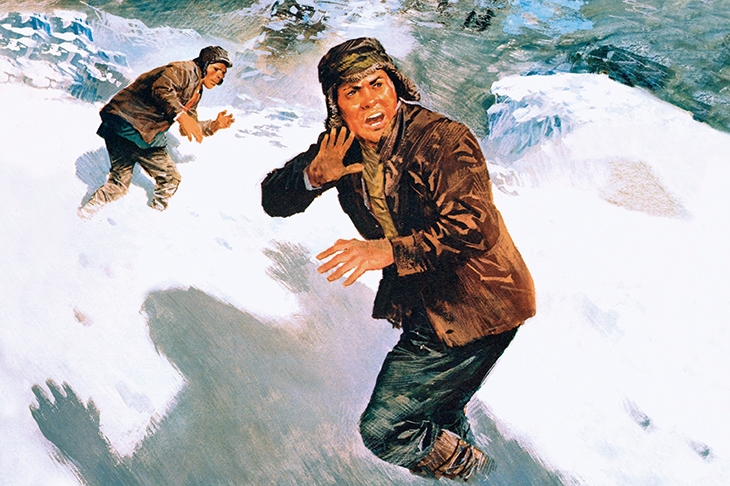In 1969 the body of an ape-like creature, preserved in ice inside an insulated box, came to light in Minnesota. Its provenance was unclear, but the rumour went round that it was a Bigfoot, the North American equivalent of the Himalayan yeti. After two days peering through the box’s glass cover, the Belgian zoologist Bernard Heuvelmans convinced himself that the rumour was correct. His description of the Minnesota Iceman was published in the Bulletin of the Royal Belgian Institute of Natural Sciences. It included the detail that ‘when erect, the penis would certainly not have been particularly striking in its dimensions’.
As if this wasn’t bad enough for the poor animal, it later transpired that its penis, along with the rest of its body, was made of latex. The whole thing was a hoax, constructed by a fairground huckster so that he could charge people 35 cents a look. As such, the Minnesota Iceman is perfectly at home in this book. The mountaineer Graham Hoyland has collected together all the claims and counter-claims surrounding the yeti and its equivalents around the world. His conclusion? There is ‘a total lack of solid evidence’.
Not that Hoyland wanted it this way. On one of his own expeditions to the Himalayas he saw footprints that locals believed had been made by a yeti. His desire to agree with them reminded him of The Third Eye, a book he read at school, in which the Tibetan T. Lobsang Rampa recounted his own meeting with a yeti. Hoyland was gripped. Unfortunately the story was a complete fabrication. T. Lobsang Rampa was actually a plumber’s son from Devon called Cyril Hoskins.
Hoyland gives every claim a fair hearing. He includes sherpas’ accounts, many of which describe female yetis possessing ‘pendulous breasts which they slung over their shoulders when they ran’. He quotes David Attenborough — ‘it is not impossible that the yeti might exist’ — and the US primatologist Jane Goodall, who attaches great weight to the countless Native Americans who claim to have seen a Bigfoot. We learn about the Daily Mail’s 1954 expedition to capture a yeti. The team included the journalist Ralph Izzard, who while covering Edmund Hillary’s Everest triumph the previous year, had arrived at base camp wearing a silk cravat, a golfing jacket and plimsolls. There’s also the Irish explorer Peter Byrne, who in 1959 stole a finger from a ‘yeti’ hand kept in a Nepalese temple. He replaced it with a human finger (his colleague ‘never asked where he got it from’), then met the Hollywood star James Stewart, who was visiting Calcutta, so that Stewart’s wife Gloria could smuggle the yeti finger out of India in her lingerie case. Tests back home revealed that it too was human.
So why will the myth of the yeti just not go away? As ever, good old human error plays a part. In his 1905 telegram reporting local sightings of the ‘Wild Man of the Snows’, Lieutenant-Colonel Charles Howard-Bury (who had entered Tibet without permission, his skin stained with walnut juice — the Viceroy Lord Curzon was not happy) included three exclamation marks to convey his personal scepticism. But these were omitted to cut costs, with the result that people believed him. As well as cock-up, however, there’s also plenty of conspiracy. Sometimes this is for money: in the 1950s the Tibetan authorities charged £400 per yeti-hunting permit, while in 2002 the Chinese province of Hubei was accused of encouraging a belief in the yeti to attract tourists.
But sometimes the conspiracies are purely for mischief. The British mountaineers Frank Smythe and Eric Shipton found footprints in the 1930s, but as Hoyland points out there’s a long tradition of climbers leaving practical jokes for their successors, such as whisky bottles filled with cold tea. (What larks.) An 11-year-old Siberian boy produced mobile phone footage showing him and his friends being terrorised by a yeti. But the figure looked remarkably like a man in a gorilla suit, and the main consequence was that the boys got into trouble with their parents for swearing.
In the end, the nearest Hoyland himself comes to encountering the yeti is a trip up Everest with Brian Blessed: the actor’s girth leads the sherpas to christen him ‘the Abdominal Snowman’. Really this book is as much about belief as it is about the yeti. It kept reminding me of Selling Hitler, Robert Harris’s brilliant account of the Hitler diaries saga. Fundamentally, people believe in fakes because they want to believe in them. That’s precisely the conclusion Hoyland reaches about Bernard Heuvelmans’s faith in the Minnesota Iceman. And it explains the success of the US TV series Finding Bigfoot, which after nine series has attracted the nickname Not Finding Bigfoot. The broadcasters ‘don’t want you to actually find it’, a producer tells Hoyland. ‘They want to keep the viewers for another season.’






Comments